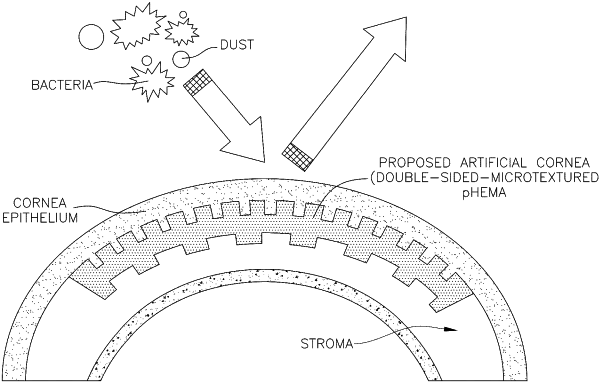| CPC A61F 2/145 (2013.01) [A61L 27/025 (2013.01); A61L 27/48 (2013.01); A61L 27/52 (2013.01); A61F 2002/0081 (2013.01); A61L 2430/16 (2013.01)] | 14 Claims |

|
1. An ocular implant, comprising:
a disc-shaped body made, at least partially, from a soft pHEMA hydrogel and having an anterior side and a posterior side opposite said anterior side, said anterior side including an anterior face extending completely across said anterior side of said body such that said anterior face has a first central region, and said posterior side including a posterior face extending completely across said posterior side of said body such that said posterior face has a second central region, wherein said disc-shaped body has a first imaginary diameter and a second imaginary diameter extending perpendicular to the first imaginary diameter and intersecting with the first imaginary diameter at an imaginary central axis oriented normal to said anterior and posterior faces of said body and passing through said first and second central regions of said anterior and posterior faces, respectively;
a first means for integrating said anterior face of said body with a corneal epithelium, said first means comprising a first plurality of micropores having diameters of larger than 1 micron to less than 100 microns, said first plurality of micropores being formed in and distributed throughout said anterior face of said body, including said first central region, and said first plurality of micropores being adapted to promote epithelial cell growth and adhesion on said anterior face of said body; and
a second means for integrating said posterior face of said body with a stroma, said second means comprising a second plurality of micropores with diameters of larger than 1 micron to less than 100 microns, said second plurality of micropores being formed in and distributed throughout said posterior face of said body, including said second central region, and said second plurality of micropores being adapted to promote growth and adhesion of keratocytes to said posterior face of said body.
|
|
5. A method of repairing a damaged cornea, comprising the steps of:
providing an ocular implant which comprises a disc-shaped body made, at least partially, from a soft pHEMA hydrogel and having an anterior side and a posterior side opposite said anterior side, said anterior side including an anterior face extending completely across said anterior side of said body such that said anterior face has a first central region, and said posterior side including a posterior face extending completely across said posterior side of said body such that said posterior face has a second central region, wherein said disc-shaped body has a first imaginary diameter and a second imaginary diameter extending perpendicular to the first imaginary diameter and intersecting with the first imaginary diameter at an imaginary central axis oriented normal to said anterior and posterior faces of said body and passing through said first and second central regions of said anterior and posterior faces, respectively, a first means comprising a plurality of micropores having diameters of larger than 1 micron to less than 100 microns, said first plurality of micropores being formed in and distributed throughout said anterior face of said body, including said first central region, and a second means comprising a plurality of micropores having diameters of larger than 1 micron to less than 100 microns, said second plurality of micropores being formed in and distributed throughout said posterior face of said body, including said second central region;
lesioning the damaged cornea of a patient;
removing dead or damaged tissue from said damaged cornea to surgically create a cornea stroma pocket;
embedding said ocular implant into said cornea stroma pocket such that said posterior face on said posterior side of said body, and hence said second plurality of micropores, interface with said stroma pocket; and
allowing said ocular implant to remain in said cornea stroma pocket such that said first means promotes epithelial cell proliferation and adhesion on said anterior face of said body, thereby inhibiting extrusion of said ocular implant, and such that said second means adheres and grows keratocytes to said posterior face of said body, thereby leading to the stable formation of stroma underneath said ocular implant.
|